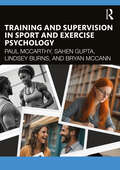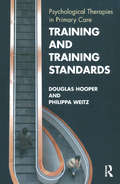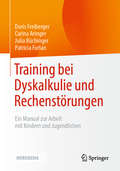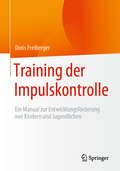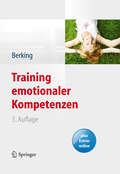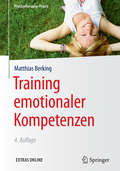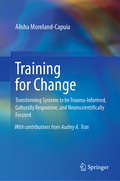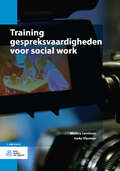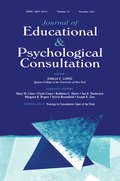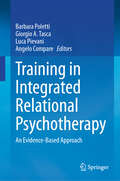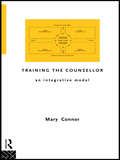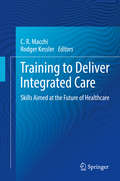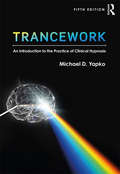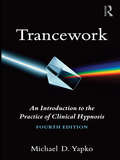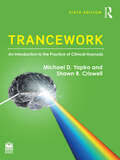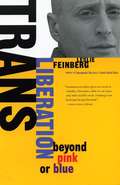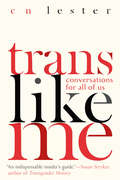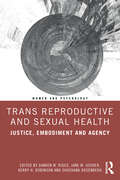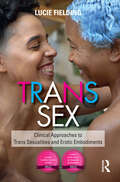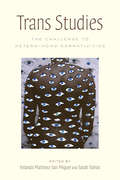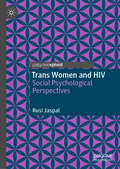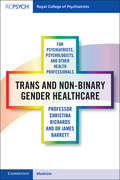- Table View
- List View
Training and Supervision in Sport and Exercise Psychology
by Paul Mccarthy Bryan McCann Lindsey Burns Sahen GuptaTraining and Supervision in Sport and Exercise Psychology presents a labyrinth of choices and challenges for trainees and supervisors, such as training and supervision mixing the science of doing sport and exercise psychology with the art of judgement and decision-making to deliver services to athletes. With a multitude of skills to master and competencies to gain, trainees and supervisors need assurances about best practice in their field and the assessments they can trust.Including cases, trainee autobiographical cases, and examples of good practice drawn from current and ex-trainees who have become sport psychology consultants, this book aims to educate trainees how to deal competently with professional and ethical guidelines. We aim to educate trainees to get started in service delivery, set up placement, work with clients, use supervision effectively, conduct academic research, and write sound assessments before preparing for a viva voce and beginning the transition to the workplace. This book shall serve trainees and their supervisors on their journey through to qualified status.Training and supervision to become a sport and exercise psychologist is of the utmost importance in the growing profession of sport and exercise psychology. This book aims to bring clarity, guidance, and support to learning and mastering professional skills in applied sport psychology service delivery. This book is key reading for undergraduates and postgraduates studying sport and exercise psychology and those studying for taught and professional doctorates in sport and exercise psychology.
Training and Training Standards: Psychological Therapies in Primary Care
by Philippa Weitz Douglas HooperThe surge of interest in psychological therapies in GP settings makes this book timely and important for the development of this field in the 21st century. As well as the suggested syllabus for training counsellors and psychotherapists (agreed by the Counselling and Psychotherapy Forum for Primary Care), the book deals with much wider issues. Chapters deal with practitioner issues - both student and professional - management issues, and the provision of supervision and mentoring for the new counsellor as well as planning Continuous Professional Development. Chapters dealing with the history of the remarkable rise in these services help set the context of the rapid development of primary care counselling. The term 'primary care counselling' denotes the context of primary care within which psychological therapies take place and encompasses practitioners from a wide variety of therapeutic traditions. The emphasis throughout is on thorough going preparation of the new counsellor/therapist to meet the proper counselling standards required in primary care practice. It will be of value to students, course providers, counselling practice managers, supervisors as well as those who commission services and general practice doctors.
Training bei Dyskalkulie und Rechenstörungen: Ein Manual zur Arbeit mit Kindern und Jugendlichen
by Doris Freiberger Carina Aringer Julia Büchinger Patricia FurlanDas vorliegende Programm ist ein umfassendes Manual, welches allen Schülerinnen und Schülern helfen soll, die Probleme mit mathematischen Grundlagen und / oder das Störungsbild der „Dyskalkulie“ entwickelt haben. Es richtet sich an Trainerinnen und Trainer, die im Bereich „Dyskalkulie“ tätig sind, Therapeutinnen und Therapeuten in diesem Bereich, sowie Kindergärten und Schulen. Das Manual dient der Prävention und als Ergänzung zum Unterrichtsstoff, ebenso zur gezielten Förderung im Einzel – oder Gruppensetting dyskalkuler Kinder und Jugendlicher.
Training der Impulskontrolle: Ein Manual zur Entwicklungsförderung von Kindern und Jugendlichen
by Doris FreibergerKinder mit einer Impulskontrollstörung fallen besonders durch ihre Persönlichkeit auf. Nach außen scheinen sie oft sehr stark zu sein, nach innen jedoch leiden sie an ihrem Unvermögen, Aufgaben so erledigen zu können wie andere gleichaltrige Kinder. Dieses Manual richtet sich an Pädagogen, Trainer und Ergotherapeuten, die mit Kindern und Jugendlichen zwischen 6-14 Jahren arbeiten und sie im Bereich der Impulskontrolle stärken möchten. Es beinhaltet komplette Stundenbilder mit Anleitungen zur Vorbereitung, benötigten Materialien und Stundenablauf.
Training emotionaler Kompetenzen
by Matthias BerkingDie eigenen Gefühle kompetent regulieren zu können - das ist zentral für die psychische Gesundheit und die effektive Auseinandersetzung mit der Umwelt. Ziel des Trainings emotionaler Kompetenzen (TEK) ist es, diese Kompetenzen systematisch aufzubauen und zu stärken. TEK wird eingesetzt (1) als flankierende Maßnahme in Ambulanz oder Klinik, (2) präventiv bei Risikogruppen, (3) Förderung der Persönlichkeitsentwicklung im nicht-klinischen Bereich. Es beruht auf den aktuellsten Befunden der klinischen Psychologie, der affektiven Neurowissenschaften und der Emotionsforschung und zeigt, wie die notwendigen Informationen über Emotionen vermittelt und effektive Emotionsregulationsstrategien erarbeitet und eingeübt werden. Alle notwendigen Materialien werden entweder im Manual oder zum Download im Internet zur Verfügung gestellt (Kursleiterunterlagen, Power-Point-Präsentation, Arbeitsblätter, Fragebogen zur Diagnostik emotionaler Kompetenzen, Patientenbroschüre, Audio-Trainingslektionen, Trainingskalender). Geschrieben für Psychologische und Ärztliche Psychotherapeuten, Klinische Psychologen, Psychiater, Mitarbeiter in Beratungsstellen.
Training emotionaler Kompetenzen
by Matthias BerkingIn diesem Buch erfahren Psychologische und #65533;rztliche Psychotherapeuten, Klinische Psychologen, Psychiater, Mitarbeiter in Beratungsstellen und Gesundheitscoaches, wie sie ihre Klienten darin unterst#65533;tzen k#65533;nnen, kompetent mit belastenden Gef#65533;hlen umzugehen. Diese F#65533;higkeit ist von zentraler Bedeutung f#65533;r Wohlbefinden und psychische Gesundheit. Das Training emotionaler Kompetenzen (TEK) ist ein transdiagnostisch orientiertes Interventionsprogramm, welches immer dann eingesetzt werden kann, wenn Defizite in der Emotionsregulation als Ursache f#65533;r reduziertes Wohlbefinden oder psychische St#65533;rungen angesehen werden. Das TEK ist prim#65533;r als Gruppentraining konzipiert, kann aber auch im Einzelsetting eingesetzt werden. Anwendungsfelder ergeben sich (1) in der Behandlung psychischer St#65533;rungen in psychotherapeutischen Praxen, Ambulanzen und Kliniken, (2) in der Pr#65533;vention psychischer Erkrankungen bei Risikogruppen, (3) f#65533;r die F#65533;rderung der Pers#65533;nlichkeitsentwicklung im nicht-klinischen Bereich. Aus dem Inhalt: Die zur Durchf#65533;hrung von TEK-Trainings notwendigen Materialien werden im Manual und zum Download im Internet zur Verf#65533;gung gestellt (Powerpoint-Pr#65533;sentation, Arbeitsbl#65533;tter, Frageb#65533;gen, Patientenbrosch#65533;re, Audio-Trainingslektionen etc. ).
Training for Change: Transforming Systems to be Trauma-Informed, Culturally Responsive, and Neuroscientifically Focused
by Alisha Moreland-CapuiaThis book offers an integrated training and coaching system to facilitate change in systems that serve youth (education, healthcare, and juvenile justice). The integrated training and coaching system combines brain development, cultural responsivity, and trauma-informed practices. The book provides a comprehensive overview of the neurobiology of fear, brain development, trauma, substance use, and mental health, structural bias and environmental factors that pose a threat to healthy brain development. The book employs practical applications/recommendations and case examples that help solidify understanding of key concepts. Each chapter begins with a set of objectives and interactive exercises that builds on the next, thoughtfully challenging the reader (and giving specific, practical ways for the reader) to apply the information presented with the goal of "change". The text is written from the perspective of a trauma-informed addiction psychiatrist who has effectively facilitated systems change. Topics featured in this book include:Common threats to healthy brain development.The neurobiology of trauma.Applying trauma-informed practices and approaches.Cannabis and its impact on the brain.Labeling theory and implicit bias.Exploring the connection between fear and trauma.Rehabilitation versus habilitation.Managing stress through mindfulness. Training for Change will be of interest to graduate and advanced undergraduate students and researchers in the fields of cognitive psychology, criminology, public health, and child and adolescent development as well as parents, teachers, judges, attorneys, preventative medicine and pediatric providers.
Training gespreksvaardigheden voor social work
by Maritza Gerritsen Ineke VlasmanBinnen het hoger sociaal agogisch onderwijs word je opgeleid tot een professional die beschikt over een kennisbasis, juiste attitude en grote beheersing van diverse (gespreks)vaardigheden. Vaardigheden die je in de complexiteit van het werkveld op de juiste manier moet inzetten om de cli#65533;nt en zijn omgeving zo goed mogelijk te helpen. Juist die vaardigheden zijn moeilijk te leren vanuit een boek, maar gaan gepaard met frequente oefening, herhaling en het ontvangen van feedback. Dit boek is daarom gecombineerd met een website waarop filmfragmenten, ondersteunende informatie en toetsmateriaal te vinden is. Het boek behandelt de meest voorkomende vaardigheden voor social workers in praktische zin en bevat een groot aantal oefeningen die je kunt gebruiken om je verder te bekwamen in het voeren van gesprekken met cli#65533;nten, hun netwerk en je collega's. In de filmfragmenten op de website worden veel voorkomende vaardigheden voor social workers getoond, zowel met als zonder nadere uitleg. Boek en website sluiten aan bij de actualiteit van het hedendaagse onderwijs, competentiegericht en praktijkgericht. Ook hebben de auteurs gekozen voor een goede aansluiting bij de actualiteit van het werkveld door zowel het werken met cli#65533;nten, als het werken namens en voor cli#65533;nten te behandelen. Dit boek is bedoeld om social workers in opleiding (mwd, sph, pedagogiek) en andere sociaal agogische professionals, te ondersteunen bij het ontwikkelen van gespreksvaardigheden.
Training in Consultation: State of the Field:a Special Double Issue of journal of Educational and Psychological Consultation
by Emilia C. LopezFirst published in 2002. Featuring new chapters on bullying, sexual assault, natural disasters, eating disorders, and cultural considerations, the second edition of this highly popular work provides a one-stop reference for mental health professionals who face a bewildering variety of school-based crises. Key features include a focus on both prevention and intervention and ongoing discussions of the research that underlies best practice.
Training in Integrated Relational Psychotherapy: An Evidence-Based Approach
by Angelo Compare Barbara Poletti Giorgio A. Tasca Luca PievaniThis edited book offers an integrative and evidence-based practice approach to training in psychotherapy, examining common factors across different therapeutic models seen through an attachment theory lens. It stresses the opportunities to handle those therapeutic situations in practice that predict patient outcomes. This edited volume will appeal to instructors and students, particularly as an introductory text on psychotherapy practice that emphasizes the fundamentals of therapist interpersonal skills and approaches. Instructors may use the book, its worksheets, and review exercises to help structure a course in psychotherapy. Individual chapters will interest trainers and students in a more advanced course that teaches interpersonally oriented therapies with an attachment theory foundation. Although written specifically for training contexts, the book will also interest practicing clinicians who wish to extend their skill set to include interventions related to those informed by attachment theory.
Training the Counsellor: An Integrative Model
by Mary ConnorIn Training the Counsellor, Mary Connor shares a decade of training experience to provide an invaluable resource for other counsellor trainers. The role of the trainer as facilitator, educator and assessor as well as key professional and ethical issues are all brought vividly to life through many case examples. The focal point of the book is the integrative, four-stage model for training competent and reflective counsellors, with the relationship between trainee and client at the core of the model. The four stages are: the development of attitudes and values; knowledge and skills; client work and supervision; reflection and evaluation. Building on this model and drawing on her own wealth of experience, the author explore the interface between being professional and being human. Training the Counsellor, offers stimulating reading and tested guidelines for good practice for all those involved in training other helping professionals.
Training to Deliver Integrated Care: Skills Aimed at the Future of Healthcare
by Rodger Kessler C. R. MacchiThis unique trainer’s resource offers a comprehensive blueprint for preparing clinicians for practice in the changing and challenging environment of integrated care. Based firmly in new evidence-based models of behavioral care in medicine, it sets out the aims and objectives of modern integrated care delivery in a streamlined pedagogy-to-practice framework. Teaching strategies for developing core skills and competencies, suitable across diverse educational and workforce development settings, are presented with data-based rationales and guidelines for design and implementation. Chapters also cover the range of essentials, from research support to business acumen to program evaluation methods, needed to meet bedrock goals of improved quality of care, clinical outcomes, and patient satisfaction. The book’s comprehensive coverage: Reviews the evidence base for integrating medical and behavioral care.Provides empirically sound guidelines for training learners in integrated practice.Breaks down skill development into critical training objectives.Offers detailed content of a current degree program in integrative behavioral medicine.Recommends measures to support responsive, patient-centered, and sustainable training programs. A robust guide to a more inclusive and effective future, Training to Deliver Integrated Care expands the healthcare horizon to accommodate trainers working in health psychology, general practice, primary care medicine, and consulting, as well as supervision and coaching professionals.
Trainingswissenschaft für die Sportpraxis: Lehrbuch für Studium, Ausbildung und Unterricht im Sport
by Alexander FerrautiDieses motivierende und reichhaltig illustrierte Lehrbuch wendet sich an Studierende im Fach Sportwissenschaft sowie an Trainer, Auszubildende und Schüler in sport- und fitnessbezogenen Berufen und dient diesen als ideale Prüfungsvorbereitung. Es ist besonders geeignet als Begleit- und Vertiefungslektüre für Vorlesungen im Fach Trainingswissenschaft.Trainingswissenschaftliche Themen werden anschaulich, gut verständlich und praxisrelevant dargestellt. Auch interessierte Leistungs- und Freizeitsportlerinnen und -sportler erhalten eine ausgewogene Mischung von evidenzbasierten sportwissenschaftlichen Erkenntnissen und praktischen Trainingstipps.Wertvolle Hinweise zu den Bereichen Leistungsdiagnostik, Trainingssteuerung, Monitoring und Wettkampfanalyse bilden das Rückgrat des Buches. Das Grundlagenwissen zum Kraft-, Schnelligkeits-, Beweglichkeits-, Ausdauer- und Techniktraining wird durch angemessene biologische Vertiefungen und durch Exkurse zu modernen Trainingsinterventionen erweitert. Dem klaren Plädoyer für Individualisierung und Sportartspezifität des Trainings wurde durch gesonderte Kapitel zu ausgewählten Sportarten Rechnung getragen. Neben dem Leistungssport, stehen auch die Besonderheiten des Trainings mit Kindern und Jugendlichen, mit Aktiven im mittleren Lebensalter oder mit älteren Masterathletinnen und -athleten im Fokus. Das Buch wagt den Spagat zwischen einer international ausgerichteten forschungsorientierten Trainingswissenschaft und der unweigerlich damit verknüpften Sportpraxis. Abgerundet wird das didaktische Konzept durch interaktives Zusatzmaterial in Form von Videobeispielen, die einfach mit der Springer Nature More Media App abgerufen werden können.
Trancework: An Introduction to the Practice of Clinical Hypnosis
by Michael D. Yapko Michael D YapkoFor nearly four decades, Trancework has been the definitive textbook for thousands of professionals undergoing training in the art and science of clinical hypnosis. Now in its 5th edition, this classic text continues its legacy of encouraging sound clinical practice based in established scientific research. This latest edition incorporates new studies and emerging topics within the field of hypnosis, including new chapters on depression and the construction of process-oriented interventions. Readers can expect to receive a comprehensive overview of current developments in the domain of hypnosis, an in-depth consideration of the practical and ethical issues associated with its use, and a greater appreciation for its many therapeutic applications. This thorough, engaging text equips professionals with the essential skills to change clients’ lives by using hypnosis to enhance treatment of both medical and psychological issues.
Trancework: An Introduction to the Practice of Clinical Hypnosis
by Michael D. YapkoFor three decades, Trancework has been the fundamental textbook for guiding professionals in learning hypnosis. Now in its fourth edition, this classic text continues to be the most comprehensive book for learning the fundamental skills of the field. This edition accommodates new studies and topics, and contains five new chapters on positive psychology, the management of pain, pediatric and adolescent hypnosis, behavioral medicine, and hypnosis across modalities. Readers can expect to receive a comprehensive overview of what is currently going on in the domain of hypnosis, an in-depth consideration of issues associated with the use of hypnosis, a greater appreciation for the diverse ways in which hypnosis can be applied, and a more detailed description of hypnotic methods and characteristics. Those new to the field will also appreciate the “Frames of Reference” sections found throughout the book, which provide insights into the work of some of the founders and leaders of clinical hypnosis. Each chapter concludes with suggestions from the author for things to consider and things to do, further emphasizing the importance of active learning. Included online at http://www.routledgementalhealth.com/books/details/9780415884945/ is the video of Dr. Yapko’s session with Vicki, an emotionally powerful and technically excellent session. For those who wish to follow along, a PDF download containing the session transcript is also available. Clinical Hypnosis has the power to change clients’ lives for the better. Trancework gives professionals the skills to do just that.
Trancework: An Introduction to the Practice of Clinical Hypnosis
by Michael D. Yapko Shawn R. CriswellFor more than four decades, Trancework has been the definitive textbook for thousands of professionals around the world undergoing training in the art and science of clinical hypnosis.Now in its 6th edition, this classic text continues its legacy of encouraging sound and insightful clinical practice based on established scientific research. This latest edition incorporates “up-to-the-minute” new studies and emerging topics within the field of hypnosis, including new chapters on trauma, dissociation, hypnotizability testing, and age regression and age progression. Special sections called “Frames of Reference” introduce readers to luminaries in the field, providing insight into the forces that have shaped current practice. Readers can expect to receive a comprehensive overview of current developments in the domain of hypnosis, an in-depth consideration of the practical and ethical issues associated with its use, and a greater appreciation for its many therapeutic applications.This thorough, engaging text equips professionals with the essential skills to change clients’ lives by using hypnosis to enhance treatment of both medical and psychological issues.
Tranquil Prisons
by Erick FabrisAntipsychotic medications are sometimes imposed on psychiatric patients deemed dangerous to themselves and others. This is based on the assumption that treatment is safe and effective, and that recovery depends on biological adjustment. Under new laws, patients can be required to remain on these medications after leaving hospitals. However, survivors attest that forced treatment used as a restraint can feel like torture, while the consequences of withdrawal can also be severe.A brave and innovative book, Tranquil Prisons is a rare academic study of psychiatric treatment written by a former mental patient. Erick Fabris's original, multidisciplinary research demonstrates how clients are pre-emptively put on chemical agents despite the possibility of alternatives. Because of this practice, patients often become dependent on psychiatric drugs that restrict movement and communication to incarcerate the body rather than heal it. Putting forth calls for professional accountability and more therapy choices for patients, Fabris's narrative is both accessible and eye-opening.
Trans Liberation: Beyond Pink or Blue
by Leslie FeinbergThis wonderfully immediate, impassioned, and stirring book is for anyone who cares about civil rights and creating a just and equitable society.
Trans Like Me: Conversations for All of Us
by Cn LesterA personal and culture-driven exploration of the most pressing questions facing the transgender community today, from a leading activist, musician, and academicIn Trans Like Me, CN Lester takes readers on a measured, thoughtful, intelligent yet approachable tour through the most important and high-profile narratives around the trans community, turning them inside out and examining where we really are in terms of progress. From the impact of the media's wording in covering trans people and issues, to the way parenting gender variant children is portrayed, Lester brings their charged personal narrative to every topic and expertly lays out the work left to be done. Trans Like Me explores the ways that we are all defined by ideas of gender--whether we live as he, she, or they--and how we can strive for authenticity in a world that forces limiting labels.
Trans People's Partnerships
by Tam SangerTo what extent are contemporary relationships shaped and limited by the social and legal discourses surrounding them? Are people becoming freer to live the lives they desire or are they manipulated subtly into these very desires? Might the insights gained through exploration of intimate partnerships, as they are currently being lived and negotiated, transform how we perceive gender, sexuality and intimacy? Do we need to think differently about how we come to be who we are, and thereby rethink how we relate to ourselves and others? These are just some of the questions thatthis bookaddresses in considering the narratives of trans people and their partners and in proposing 'the ethics of intimacy', or the rethinking of intimate selves in order to increase freedom from domination and governance. "
Trans Reproductive and Sexual Health: Justice, Embodiment and Agency (Women and Psychology)
by Damien W. Riggs Kerry H. Robinson Jane M. Ussher Shoshana RosenbergFocusing on reproductive and sexual justice, this important book explores in detail both the challenges that trans people face when negotiating reproductive and sexual health in restrictive social contexts, and their agency in advocating for change. Chapters cover a breadth of topics such as intimacy, sexual violence, reproductive intentions, sexuality education, oncology, and pregnancy, introducing readers to the latest research in the field as well as key emerging concepts. The authors identify core principles for trans reproductive and sexual justice, providing a broad overview of what is currently succeeding and what can be built on going into the future. Trans Reproductive and Sexual Health offers a comprehensive exploration that is essential reading for academics and students in psychology, sociology, gender studies, and related areas, as well as clinicians and policy makers, offering direct implications for professional audiences working in health and social care.
Trans Sex: Clinical Approaches to Trans Sexualities and Erotic Embodiments
by Lucie FieldingDespite the increasing visibility of trans and non-binary folx in media, political representation, and popular culture, their sexual lives and erotic embodiments are woefully under-attended-to in both scholarship and clinical practice. The aim of this book is to equip providers with both conceptual frameworks and concrete tools for better engaging their trans, non-binary, and gender expansive clients in pleasure-centered discussions of sexual health. Challenging the dominant images of trans sexualities that appear in the existing literature, such as an emphasis on avoiding gender dysphoria, the preservation of sexual function, or on sexual losses that may arise as a result of transition pathways, Trans Sex offers a pleasure-positive approach to working with trans clients. Providing concrete clinical practices and practical activities that utilize social justice, intersectional trans feminism, and radical queer theory as key conceptual frameworks, this groundbreaking text is designed to be accessible to a wide range of providers. This book draws on Fielding’s experiences as both a trans client/patient and as a therapist to shift and expand the conversation and includes contributions from other trans and non-binary providers working at the intersection of gender-affirmative care and sexuality. Trans Sex seeks to move trans sexualities from the margins of gender-affirmative clinical practice, to center pleasure, and to spark creativity and empathic attunement within the client-provider relationship. Whether they be mental health or medical providers, trainees, or seasoned practitioners in gender-affirmative work or sexualities, readers will be able harness creative strategies to enhance their practice and become more imaginative providers.
Trans Studies: The Challenge to Hetero/Homo Normativities
by Sarah Tobias Genny Beemyn Susan R. Rankin Jian Chen Marcia Ochoa Alexandra Rodriguez de Ruiz Valens Keja Nora Butler Burke Lucas Crawford Yolanda Martinez-San Miguel Aren Z. Aizura Sel J. Hwahng Yolanda Martínez-San Miguel A. Finn Enke Pauline Park Jody L. Herman Toby Beauchamp Mickael Chacha EnriquezFrom Caitlyn Jenner to Laverne Cox, transgender people have rapidly gained public visibility, contesting many basic assumptions about what gender and embodiment mean. The vibrant discipline of Trans Studies explores such challenges in depth, building on the insights of queer and feminist theory to raise provocative questions about the relationships among gender, sexuality, and accepted social norms. Trans Studies is an interdisciplinary essay collection, bringing together leading experts in this burgeoning field and offering insights about how transgender activism and scholarship might transform scholarship and public policy. Taking an intersectional approach, this theoretically sophisticated book deeply grounded in real-world concerns bridges the gaps between activism and academia by offering examples of cutting-edge activism, research, and pedagogy.
Trans Women and HIV: Social Psychological Perspectives
by Rusi JaspalThis book explores the social psychological aspects of trans women’s experiences of living with HIV in the UK. Drawing on theories from social psychology, the author provides a fine-grained analysis of the EXTRA Study – one of the first in-depth empirical studies of trans women’s experiences of living with HIV in the UK.Trans Women and HIV: Social Psychological Perspectives examines issues of identity, threat and coping among trans women – a key population in the HIV epidemic – and presents a model for describing and predicting health outcomes in this population. Underpinned by the Health Adversity Risk Model, this book examines the role of psychological constructs, such as identity, risk and stigma, in behaviour and psychological wellbeing. This informative and thought-provoking text is an invaluable resource for scholars, clinicians and students working in the fields of HIV and trans health.
Trans and Non-binary Gender Healthcare for Psychiatrists, Psychologists, and Other Health Professionals
by Christina Richards James BarrettGender diversity is now recognised as simply part of human diversity, rather than being pathological. This shift calls for a need for mental health professionals to adapt their practice when working with trans and non-binary people. Written by two clinicians with significant experience in this field, this book provides practical, everyday advice on what to do when seeing gender-diverse people in both inpatient and outpatient settings. It avoids focusing on academic theory or being overly political and, instead, offers straightforward, useful guidance on common issues clinicians may face, such as which ward to accommodate someone on or which name to use when. Topics include common drug interactions, differential diagnoses, complex case formulation, autistic spectrum conditions, the spectrum of sexualities, surgeries, legal and religious matters, forensic assessment, psychotherapy and mental health diagnoses. Fully relevant to contemporary practice, this is a much-needed guide for busy clinicians seeking immediate, practical and authoritative answers.
